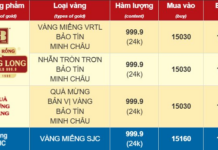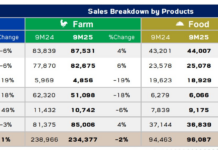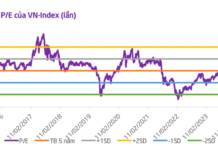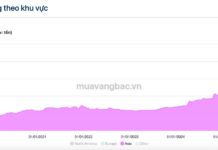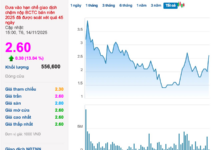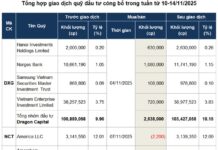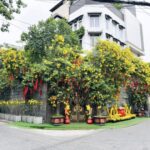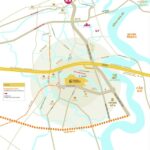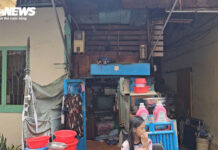The “Path” of 9 Metro Lines Prioritized for Early Construction
Recently, the Ho Chi Minh City Urban Railway Management Board announced that from now until 2035, the city plans to invest approximately $37.15 billion to develop 9 metro lines, including 6 lines in the central area, 2 lines in former Binh Duong, and 1 line towards Vung Tau (former).

Planning of Metro Line No. 1 (New Binh Duong City – Suoi Tien Station)
In former Binh Duong, Metro Line No. 1 (New Binh Duong City – Suoi Tien) has a total length of 32.43km, including a 29.01km main line entirely elevated and a 3.42km depot connection. The total investment is expected to be $2.27 billion. On August 16, the Ho Chi Minh City People’s Committee decided to assign the Urban Railway Management Board as the investor, initiating the investment preparation for this metro line.
The project starts at the center of New Binh Duong City in Phu Hoa Ward, Thu Dau Mot City, former Binh Duong, and ends at Suoi Tien Bus Station (Ho Chi Minh City’s Metro Line No. 1) in Binh Thang Ward, Di An City, former Binh Duong. The line features 19 elevated stations and 1 depot in Phu Chanh Ward, Tan Uyen City (former).
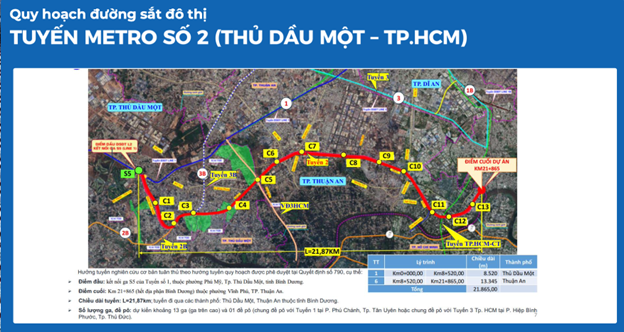
Planning of Metro Line No. 2 (Thu Dau Mot – Ho Chi Minh City)
Metro Line No. 2 (Thu Dau Mot – Ho Chi Minh City) spans 21.87km, entirely elevated, starting from S5 station of Metro Line No. 1 in Phu My Ward (former Thu Dau Mot City), passing through Binh Hoa Ward, and ending in Vinh Phu Ward (former Thuan An City).
It connects with Ho Chi Minh City’s Metro Line No. 3 at Hiep Binh Phuoc (former). The line includes 13 elevated stations and shares a depot with Ho Chi Minh City’s Metro Line No. 3. Future plans extend it to Binh Duong Ward, linking with Metro Line No. 1 and connecting to Chon Thanh (Dong Nai) and Hoa Lu Border Gate, paralleling National Highway 13 and the Ho Chi Minh City – Chon Thanh – Hoa Lu Expressway (CT30), forming a seamless regional transport axis. The total investment is estimated at $2.27 billion.
Previously, the Ho Chi Minh City People’s Committee assigned the Urban Railway Management Board as the investor and to prepare investments for Metro Line No. 1 (New Binh Duong City – Suoi Tien) and Metro Line No. 2 (Thu Dau Mot – Hiep Binh Phuoc). These projects will bypass investment policy approval and proceed directly to project development.
Additionally, Line No. 1 (An Ha – Suoi Tien) spans 40.8 km, with 15.5 km underground and 25.3 km elevated. It includes 30 stations (14 underground, 16 elevated) and uses An Ha and Long Binh depots. The preliminary investment is $3.28 billion.
Metro Line No. 2 (Thu Thiem – Cu Chi) covers 62.17 km, with 12.83 km underground and 49.34 km elevated. It features 42 stations (12 underground, 30 elevated) and uses Binh My (Cu Chi), Tham Luong, and Phuoc Hiep depots. The estimated investment is $2.77 billion.
Metro Line No. 3 (An Ha – Hiep Binh Phuoc) spans 45.81 km, with 16.05 km underground and 29.77 km elevated. It includes 35 stations (15 underground, 20 elevated) and uses An Ha, Tan Kien, and Hiep Binh Phuoc depots. The expected investment is $5.05 billion.
Metro Line No. 4 (Dong Thanh – Hiep Phuoc) covers 47.32 km, with 25.62 km underground and 21.7 km elevated. It features 37 stations (21 underground, 16 elevated) and uses Dong Thanh (Hoc Mon) and Hiep Phuoc depots. The preliminary investment is $5.96 billion.
Line No. 6 (Inner Ring Road) spans 53.8 km, with an investment exceeding $8 billion. It includes 45.6 km underground and 8.2 km elevated, featuring 38 stations (32 underground, 6 elevated) and using Binh Hung, Binh Trieu, Hiep Binh Phuoc, and Long Truong depots.
Thu Thiem – Long Thanh Line spans 41.83 km, with an estimated investment of $3.21 billion, connecting Ho Chi Minh City center (Thu Thiem Station) to Long Thanh International Airport. It includes 40.67 km elevated, 15.13 km underground, and 0.43 km at-grade, with 20 stations (16 elevated, 4 underground).
Metro Line No. 3 Vung Tau – Ba Ria – Phu My spans 63 km, including a 23 km connection to Long Thanh Airport (previously planned at 40 km). The expected investment is $4.83 billion.
Two other critical lines in this phase are Line No. 12 Ho Chi Minh City – Can Gio and Metro Line No. 2 (Ben Thanh – Tham Luong).

9 prioritized metro lines with a total investment of over $37 billion.
According to the 2021-2030 urban railway network plan, with a vision to 2050, former Binh Duong (now part of Ho Chi Minh City) will invest in 12 metro lines connecting internally and with Ho Chi Minh City – Dong Nai.
Ho Chi Minh City will also plan 12 lines totaling 582 km. Upon completion, this metro network will become the backbone of public transport in the Southeast region, seamlessly connecting the new Ho Chi Minh City, integrating with the national railway system and Long Thanh Airport, reducing congestion, modernizing infrastructure, and driving regional economic development.
Infrastructure Driving Sustainable Urban Development
At the 2025 Housing Real Estate Forum, Dr. Arch. Ngo Viet Nam Son, an urban planning expert, stated that infrastructure not only serves public needs but also becomes a tool for sustainable financial resources.
He believes that post-merger, urban and economic development in Vietnam opens up integration opportunities, from socio-economics and maritime economics to logistics and international trade. Diverse urban models such as port cities, industrial cities, airport cities, and TOD (Transit-Oriented Development) cities linked with high-speed rail, metro, and BRT systems will be prioritized.
The efficiency of two-tier local governance is expected to significantly streamline administrative procedures, simplify project approval and licensing, enhancing flexibility, reducing delays, and attracting investors.
According to Dr. Nam Son, post-merger, Ho Chi Minh City’s socio-economic potential grows significantly. The city can re-plan seaports, river ports, connect coastal infrastructure with highways, railways, and multimodal logistics, fostering projects linked to seaports, industrial cities, and coastal tourism. The Ho Chi Minh City megacity will expand its international connectivity, from export-import logistics to border-gate urban chains and TOD cities integrated with public transport.
However, alongside opportunities, challenges remain, particularly the need for long-term vision, legal framework innovation, urban planning adjustments, smart management, and human resource quality. Regional and international competition will pressure development. Overcoming these requires an integrated long-term vision for Ho Chi Minh City – Binh Duong – Ba Ria Vung Tau, combined with sub-regional megacity cooperation programs to attract substantial capital.

Ho Chi Minh City’s urban railway network with a total length of 1,012 km.
“For successful TOD development, the most crucial aspect is establishing a transparent legal framework, with the ‘dual pricing’ mechanism being key. Resolving land clearance and compensation issues will enable TOD to create modern infrastructure, efficiently utilize land resources, contribute directly to the budget, and promote sustainable urban development,” emphasized Dr. Arch. Ngo Viet Nam Son.
Why Đàm Vĩnh Sold His Hundred-Billion-Dong, Dual-Frontage Villa in Ho Chi Minh City
The news of Dam Vinh Hung selling his luxurious villa, valued at over a hundred billion VND, with a prime double-frontage location in Ho Chi Minh City, has captured the attention of many. This stunning property is a testament to the singer’s success and has become a topic of interest among fans and real estate enthusiasts alike.
Ho Chi Minh City Supports Tay Ninh with VND 1.806 Trillion for Expressway Development
Land clearance and investor selection are underway, targeting a March 2026 groundbreaking for the HCMC – Moc Bai Expressway.
Ho Chi Minh City Selects Investors for Two Urban Areas Spanning Over 516 Hectares
Unveiling a new era of urban development, the Binh Quoi – Thanh Da New Urban Area (Binh Quoi Ward) and the Ben Dinh Islet New Urban Area (Vung Tau Ward) span a combined area of over 516 hectares. These ambitious projects are poised to revolutionize the urban landscape of the central and coastal regions, setting a new benchmark for innovative city planning and growth.
T&T City Millennia: Unlocking Immediate Commercial Opportunities
In the evolving landscape of the real estate market, as it enters a phase of restructuring, capital is becoming increasingly selective. Today’s investors prioritize assets that offer both immediate operational value and long-term growth potential—where “money can generate returns while awaiting capital appreciation.”
Rach Chiec Sports Complex in Ho Chi Minh City Set to Break Ground on December 19th
Ho Chi Minh City has halted the compensation and land clearance policy for the Rạch Chiếc National Sports Complex project, a BT (Build-Transfer) initiative with an investment value exceeding 8,000 billion VND.









